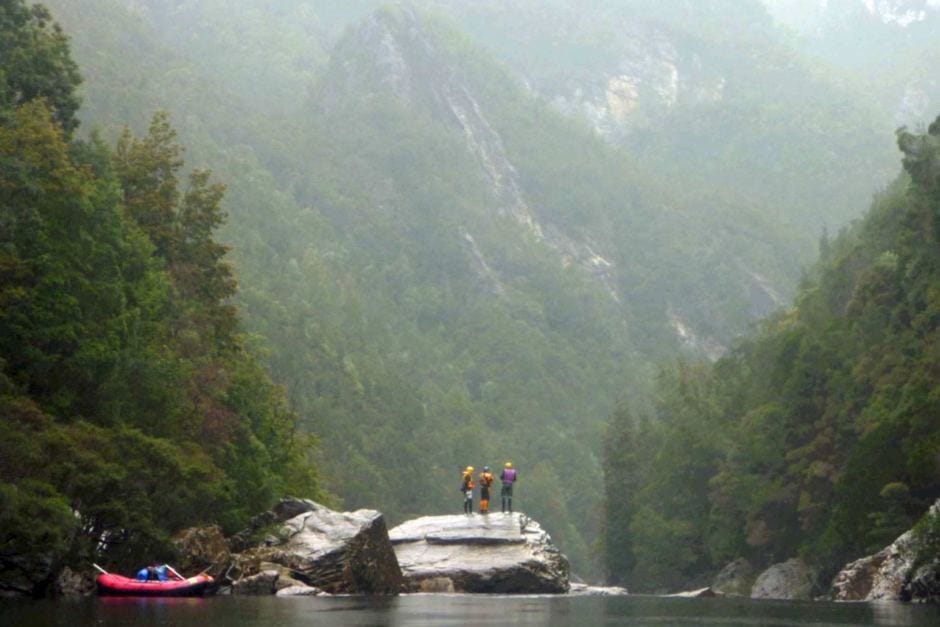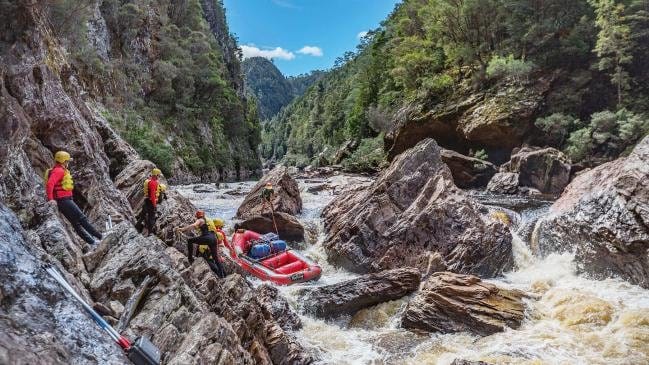
In December of 2017, seven of us ventured Down Under to boat a river only one of us had ever heard of before this trip was planned - the Franklin River. This is our story. It will take several ‘parts’ for me to tell it. I’ll post a ‘part’ - whenever I can - until the story, from my perspective, is complete.
A couple of weeks back in the retelling of our story, we reached the Great Ravine on the Franklin River, portaged the first waterfall called The Churn, spent our night in caves and then rendezvoused with the commercial trip we had met in the Irenabyss at the camp just above our second major stretch of whitewater called The Coruscades.
Our trip down the Franklin, and a short, but memorable section of the Gordon, was 129 kilometers long. About 80 miles American. It’s a trip that should, under normal conditions, require a week to eight days. An aggressive, skilled kayaker could manage it in four days. We were advised to allow 11 to 12 days in the event the weather and the river decided to have a high water event as we had seen via the graphs before we had launched.
The Great Ravine is one section of that journey, a very short section actually, but it harbors the most serious whitewater and arduous portages. Within the Great Ravine are four rapids of note: The Churn, The Coruscades, Thunderush and the Cauldron. Each need to be approached with an abundance of caution because a mistake with any of them could be fatal.
It’s imperative you reach and portage the third monstrous rapid in the gorge - Thunderush - when the river is not varying high. Because the only portage is along the shore over massive boulders on river left while the water level is on the calmer side. An old high water portage on the right bank, involving humping your gear over land, above the cliffs and through the matted forest had been eliminated some years back by a rock slide.

Day Two in The Great Ravine was going to be a big day.
We were to reconnoiter the intimidating rapid called The Coruscades, determine whether we needed to portage or were able to raft it, and then paddle another still water reach, blessed with another blissful sounding name and then schlepp our way around Thunderush Rapids. In other words, we were shooting to put all but the last major drop in The Great Ravine behind us.
No significant amount of rainfall had happened, but the air on the Franklin was often laden with moisture. Sometimes it was like a fine mist. The sort of fine mist you find at restaurants in very hot settings. Mist that blanketed the rainforest around us, condensed on the surrounding foliage, drizzled to the forest floor and worked it way into the Franklin River.
The river had perceptibly risen as we started into The Great Ravine, and that was an ever present consideration in the backs of our minds. It honestly felt like we were ‘on the clock’. Time wasn’t necessarily our friend.
The commercial crew at the camp on the left bank just at the lip of The Coruscades were enjoying a layover day. A few were lounging like lizards on gargantuan boulders lining the rapid’s left shore. They were quick to offer encouragement and advice. They readily offered that the slightly swollen river was at the ideal level for paddling the Class V whitewater on this portion of the Franklin.
This was cheering news to our four bold boaters.
My boat partner didn’t need to scout beyond the entrance to know he had no interest in challenging The Coruscades. The start of the drop was straightforward but the conclusion was punctuated with a nasty and, more importantly, unavoidable reversal which was only a short distance away from a series of sharp drops and boulder choked channels.
He was adamant about not risking a swim on The Coruscades. I did not argue and was, in fact, relieved.
(The wave awaiting at the bottom of The Corsucades reminded me of the first time I scouted Lava Falls on the Grand Canyon. It was 1982 before the advent of self-bailing rafts. A raft that needed to be bailed could tip the scales at a few thousand pounds once loaded with water. Paraphrasing the author of The Emerald Mile, “Imagine something with the agility of a dead manatee.”
For a long time after the advent of boats that bailed themselves, Grand Canyon guides would dicker over whether the extra weight going into the big whitewater on the Canyon was on the plus side of the ledger or the minus. Everybody seems to agree now that you want the agility of something more nimble than a dead manatee.
That first look at Lava Falls was an epic four hours in length - at minimum. I have since learned that ANY scout over twenty minutes is deleterious to both the group’s morale and your own. Though I wouldn’t ever go as far as the former outfitter Ken Warren who once said about allowing his guides to scout during their first descent of the Yangtze River in China, “I don’t allow them to scout. If I did, then they wouldn’t want to run it!”
Periodically, a raft from one of the three parties at our scout of Lava Falls would make an attempt at one of the three identifiable route options - The Hateful Right Side, The Bubble Run or The Grey Area. The righthand run had already flipped a couple of rafts and one of them had drifted upside down out of sight. We eagerly awaited a test run of the left route, or The Grey Area.
We watched from the terrace above the rapid as an 18 foot Avon inflatable picked its way down the lefthand side of Lava known as The Grey Area. I distinctly recall the loaded oar boat with three people onboard get engulfed in a wave similar to the one lying in wait on The Coruscades. The entire raft disappeared from view for a split second before surfacing like a submarine.
I distinctly recall the audible gasps and then the tentative cheers when they breached because, even though they remained upright, there was nothing encouraging about their route. Especially for my group’s smaller rafts.)
My partner and I were quite mindful of the wilderness aspect of our journey. Challenges that made sense in the ‘front country’, or someplace you could reach a hospital in under an hour, were too treacherous in the back country where a hospital was more than 24 hours away. In addition, neither of us were Olympic swimmers or former water polo players, so the thought of an involuntary swim on a rapid when we had another non-lethal option was less than appealing.
Our minds were made up. Even after watching the first two rafts successfully push through the stopper wave at the foot of rapid, neither of us were inclined to test it for ourselves. Fortunately, our two lead boaters were willing to expend another dose of adrenalin and risk it again by walking back up and paddling our boat down to the eddy below, crashing through the bottom breaking wave one more time.
Casting the die one more time.
Standing at the foot of The Coruscades was not the relief I had hoped for. Rapids continued downstream for several hundred yards and, though they did not come with the reputation of the second major drop in The Great Ravine, they were a jigsaw puzzle of rocks, channels and five foot drops. A sluice box dotted with immovable obstacles.
A Grand Canyon ranger once cheerily told my group, “Hey! It’s nothing but water, rocks and gravity!”
I’d like to say that expression consoles me during my times of whitewater nerves, but I’d be lying.
###
I have not forgotten about the Angry Yam or COVID19. Check out Randy Rainbow’s latest masterpiece.


Also, the state of Mississippi made an historic decision yesterday to replace their state flag that incorporates the Confederacy’s Stars and Bars. About freakin’ time!
Keep up the unrest. It’s having an effect.
I hadn’t forgotten about the racial unease and you shouldn’t either!




